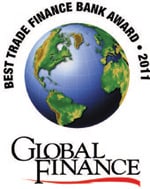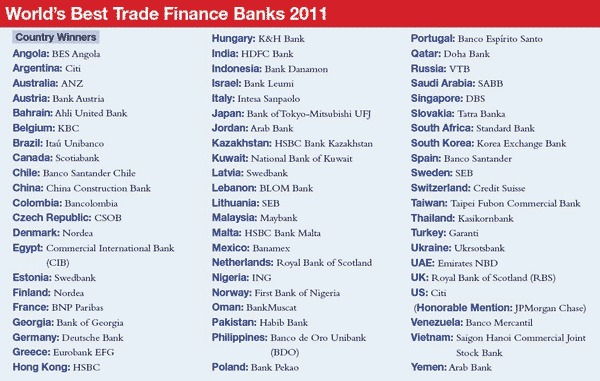TRADE FORECAST: CLOUDY WITH A CHANCE OF PROTECTIONISM
By Gordon Platt
Bankers are optimistic that financing will be available to support projected growth in world trade, but regulatory change and currency wars have them on edge.

Trade finance is the fuel that powers the engine of world trade, which is helping to pull the world economy out of recession. That fuel could get significantly more expensive, however, if the backers of Basel III get their way, trade bankers say, and world economic growth could suffer as a result.
A proposed increase in capital requirements will have a deleterious effect on the cost and availability of trade credit, bankers say. It will also throw sand in the gears of export initiatives, such as President Barack Obama’s plan to double US exports and create jobs. Every $1 billion of exports supports 7,400 US jobs, according to the Export-Import Bank.
Trade bankers contend that the short-term and self-liquidating nature of trade finance, which is often collateralized by the underlying shipment of goods, makes it one of the safest forms of lending. They are lobbying regulators to heed recommendations of G20 leaders to be flexible in applying new rules, so as not to disrupt global trade. Emerging markets are particularly vulnerable because they rely more heavily on letters of credit to facilitate trade. Bankers say current prices for trade finance cannot be sustained if banks are forced to pay more for their capital.
The currency wars are a bigger threat to trade, according to some bankers. They worry that protectionist forces will gain the upper hand if export-dependent economies seek to defend market shares through competitive devaluations. The controversy surrounding the undervalued Chinese renminbi and intervention by the central banks of Japan and Switzerland to halt the rise of their currencies show that there is a fine line between market-smoothing operations and currency manipulation, trade bankers say. Beggar-thy-neighbor currency policies could result in a trade war, leading to higher tariffs and other barriers to international commerce.
Meanwhile, the trade finance business is continuing to consolidate. The growing trade flows between developing economies require successful trade banks to have extensive networks, with on-the-ground capabilities linked to global platforms offering a wide range of trade services and financing. The best trade banks are constantly innovating and enhancing their trade products to meet the evolving needs of their customers.
Global Finance editors, with input from industry analysts, corporate executives and technology experts, selected the best trade finance banks in 71 countries or regions. Criteria for choosing the winners included transaction volume, scope of global coverage, customer service, competitive pricing and innovative technology. Risk mitigation has become an increasingly important concern in the wake of the global financial crisis. As global supply chains become ever more complex, they are susceptible to a wide range of risks.
The best trade bankers go the extra mile to understand their clients’ businesses. This enables them to offer useful advice on potential risks and how to manage them. The top banks also are adept at using special programs available through export credit agencies. Guarantees that lower the cost of working capital, export-credit insurance against nonpayment, and loans to assist foreign buyers are available. The winners are those banks that best serve the needs of corporations as they engage in cross-border trade.
REGIONAL WINNERS
Americas
Citi
Citi provides trade finance services in 86 countries, with a market-leading network that handles more than two million cross-border trade transactions a year. “Our globality as well as our local expertise have helped us to continue to meet our clients’ trade-financing needs and garner market recognition for Citi,” says John Ahearn, managing director and global head of trade, who is based in New York. There will likely be a consolidation of the trade business in the coming year, and Citi can play the role of industry consolidator, he says.
Banks for which trade is not a core business line may decide that the increased capital costs in the postcrisis environment are too high to make the business worthwhile for them. “In general, with these new requirements, banks won’t have the capital to operate in every business line,” Ahearn says. “Those banks that treat trade finance as a hobby could outsource, exit the business or go into partnership with someone else.”

“In general, with these new requirements, banks won’t have the capital to operate in every business line.”
“Those banks that treat trade finance as a hobby could outsource, exit the business or go into partnership with someone else” – John Ahearn, Citi
The traditional book-and-hold strategy of issuing trade credits is no longer sustainable, Ahearn believes. Citi introduced an innovative Multi-Bank Global Trade Program at Sibos in Amsterdam in October 2010 that will enable a group of participating banks to originate and fund trade finance assets more efficiently through a structured issuance of asset-backed securities and commercial paper. “We are building this program as a way for the industry to provide dollar liquidity,” Ahearn says. Citi is lead arranger, anchor tenant and syndicate agent for this global initiative. Participating banks share a common goal of creating the most efficient funding platform to support the financing of global trade flows, Ahearn explains. Banks will begin to act as intermediaries between corporations and investors with lower funding costs. The originate-to-distribute model of trade securitization provides an off-balance-sheet solution that will enable banks to actively manage their trade assets.
Meanwhile, Citi was the first bank to make use of the US Export-Import Bank’s new supply-chain finance guarantee program to support small businesses. The program is part of President Obama’s National Export Initiative. Ex-Im Bank is providing a 90% guarantee to support up to $100 million of liquidity from Citi to small and medium-size US-based suppliers.
Europe
BNP Paribas
BNP Paribas is a leading global trade finance bank with a pan-European presence and a network of 100 trade centers worldwide. In February 2010 the Paris-based bank established four competence centers at the Brussels headquarters of BNP Paribas Fortis offering a range of services to companies operating internationally. Thierry Josz, head of global trade solutions (GTS), who also heads the competence center for trade services, says the size and positioning of the bank are critical to its success in trade finance. “We are everywhere in the world, and our focus is on offering high-quality services,” he says.
BNP Paribas’s worldwide trade operations are supervised from its Brussels competence center, where experts field questions on specialized issues, such as back-to-back letters of credit and sophisticated trade-related guarantees. The Brussels competence center is also responsible for e-trade product development. GTS offers three types of products: documentary credits and payment collections, trade-related guarantees, and e-commerce platforms to manage supply chains and help companies make the best use of their working capital.

“There are some indications of a recovery in global trade, but there also is some hesitation in the market”
“There are questions about whether the global economic recovery is sustainable” – Thierry Josz, BNP Paribas
“There are some indications of a recovery in global trade, but there also is some hesitation in the market,” Josz says. “There are questions about whether the global economic recovery is sustainable and some worries that pressures on currencies such as the dollar and the Chinese renminbi could trigger more protectionism.”
BNP Paribas has a strong presence in emerging markets, and it expects China and India to lead future growth in world trade, with intra-Asia trade growing particularly fast. “I would be surprised if the short-term country ratings for China and India do not improve,” Josz says. “They are powerful trading economies with huge surpluses and reliable growth.” Poland and Turkey are also promising markets with international orientations and exporting capacity, he says.
Asia
Standard Chartered Bank
Standard Chartered Bank has more than 150 years of history in Asia, including China and India. “We started as a trade finance bank and trade finance remains part and parcel of our DNA,” says Tan Kah Chye, global head of corporate cash and trade, who is based in Singapore. “Despite our long history, we have not forgotten the importance of innovation. We were the first bank to offer buyer and supplier finance on a cross-border basis and the first to use iPhone and iPad technology to facilitate our clients’ trade flows.”
Standard Chartered was the first foreign bank to obtain a settlement and agency bank license in China and is the leading foreign bank in renminbi trade settlement. It was also the first foreign bank to facilitate renminbi payments and collections for cross-border trade with China.

“Despite our long history, we have not forgotten the importance of innovation”
“We were the first bank to offer buyer and supplier finance on a cross-border basis and the first to use iPhone and iPad technology to facilitate our clients’ trade flows” – Tan Kah Chye, Standard Chartered
Standard Chartered operates on a global basis, but its network is focused on the emerging markets of Asia, Africa and the Middle East. “We took advantage of the global financial crisis to increase our trade finance market share,” Tan says. “We understand the importance of being client-centric, and we held face-to-face meetings with our clients to help them with their problems throughout the crisis. We stuck with them during good and bad times, and this has paid off,” he says.
The bank’s success in trade finance is also owing to its strong balance sheet, Tan says. “Not only did we survive the crisis, but we also thrived. Our share price is now well above the precrisis level.”
Standard Chartered is also trying to make sure that world trade does not become a victim of new regulations ranging from Basel III to anti-money-laundering rules. “We want to ensure that regulators understand the importance of trade to the global economy and that policies are aligned to trade finance dynamics,” says Tan, who last September was appointed chairman of the ICC Banking Commission, which has more than 500 members in 85 countries. “One problem is how banks will be able to raise the new capital in the current environment,” he says. “If they are not able to do so, there could be a 6% reduction in trade finance capacity and a 20% to 40% increase in price.”
There is a healthy capacity in the market today, but prices remain well above precrisis levels, Tan says. Global trade is recovering, although the rebound is not as robust in the developed economies, he says. “Emerging markets are in different stages of development and will lead the growth in world trade for the next decade.”
Central & Eastern Europe
UniCredit
UniCredit has an unrivaled presence in Central & Eastern Europe, with more than 4,000 branches in 19 countries. “We are among the top three financial institutions in most CEE countries, and we offer fully fledged banking services,” says Markus Wohlgeschaffen, head of global trade finance and services.
UniCredit not only draws on its trade expertise on the ground in the CEE region to serve its clients, but it also offers the trade capabilities of UniCredit Group. Its core operations in Italy, Austria and Germany offer links to approximately 3,500 correspondent banks worldwide that extend its reach. UniCredit has invested in processing systems and front-end systems to safeguard efficient handling of the commercial foreign trade business as well as supply-chain financing technology. In 2010 it extended online applications for letters of credit and guarantees to Bulgaria, Serbia, Slovenia and Ukraine, as well as the Baltic countries.

“The economies of the CEE region are picking up again”
“It started with private demand and is now showing up in exports, with intra-CEE trade particularly strong” – Markus Wohlgeschaffen, UniCredit
“The economies of the CEE region are picking up again,” Wohlgeschaffen says. “It started with private demand and is now showing up in exports, with intra-CEE trade particularly strong.”
Growth in CEE trade will be in the low double digits in percentage terms in 2011 and it will be driven by exports, says Andrew England, head of global transaction banking, CEE, at UniCredit. As economic recovery takes hold throughout the region, imports will also head higher, England says. “UniCredit has reinforced its focus on trade and added more competence in many CEE countries, including Russia, Croatia, Hungary and Romania,” he says.
The bank is encouraging its customer-relationship managers to talk to their existing clients about risk mitigation and to explain how companies can benefit by using letters of credit in the current economic climate, England says. There is difficulty in accessing financing, and buyers are often trying to pay late, he notes. “Smaller suppliers are looking for buyer credits for transactions within a country,” England says. “We can help buyers to support their suppliers.”
The big emerging markets are driving the growth in cross-border trade, particularly Poland, Turkey and Russia, he says. As long as the price of oil holds above $75 a barrel, big infrastructure projects and the reactivation of industrial plants in Russia will boost trade with other countries in the region, England adds. The Baltic countries are exhibiting a strong improvement in trade, with much of it linked to Russia and Scandinavia.
Nordic Region
SEB
Stockholm-based SEB has experienced rapid growth in its trade finance market share in the Nordic countries—Sweden, Norway, Denmark and Finland—in the past few years. The bank offers a wide range of financial services in Sweden and the Baltic countries. It focuses on corporate and investment banking in Norway, Denmark, Finland and Germany. SEB has the largest global trade finance network of all Nordic banks. Its clients include 85% of the largest corporations in the region. Many of them are heavily involved in exporting, owing to their relatively small home markets.
“The Nordic region is a complex and competitive market, which keeps us on our toes and drives us to develop close relations with our customers,” says Lars Millberg, head of GTS-corporates. “We are very familiar with export markets, and we work constantly to improve our clients’ cash flow, risk management and documentary trade processing.” SEB outsources many of its back-office services, giving it access to the latest technology. All of its trade products and services are accessible through its online trade finance application.
“The trade finance business is commoditized”
“The only way a bank can distinguish itself is by having the best people and the best customer contact” – Lars Millberg, SEB
“The trade finance business is commoditized, which means that the only way a bank can distinguish itself is by having the best people and the best customer contact,” Millberg says. SEB focuses on developing long-term relationships with its clients. “We can provide far more value if we focus on all of the payment flows of our clients, and not just on trade flows,” Millberg says.
The Benche, SEB’s online forum for social networking in trade finance, has proved so popular that it has been extended to cash management and custody. It is integrated with other social media and has its own podcast on iTunes.
Middle East
Arab Bank
Arab Bank has a global network of more than 500 branches in 30 countries, with blanket coverage of the Middle East region. “Arab Bank has been focused on being an international bank with regional coverage since its inception,” says Abdel Hamid Shoman, executive chairman. “The vision of the bank following its establishment in the 1930s was based on this mission, being an Arab bank not only to its own regional community but to the international community as a whole.” The bank has the largest geographical coverage of any Middle East–based bank.
“In connecting the world to MENA [Middle East and North Africa], trade finance is naturally one of the main focuses we have supported over the decades,” Shoman says. “With that vision comes responsibilities. It was critical that we become a true local bank in the countries where we operate and develop local expertise, so that we can be the true bridge between the Middle East and the rest of the world.”

“In connecting the world to MENA, trade finance is naturally one of the main focuses we have supported”
“It was critical that we become a true local bank in the countries where we operate and develop local expertise” – Abdel Hamid Shoman, Arab Bank
Arab Bank’s expertise and physical presence extends to Asia, enabling its local trade teams in China, South Korea and Singapore to work closely with its institutional and corporate customers in the region. The trade relationship between the Middle East and Asia is expanding, with China being the leading exporter to the Middle East.
“Latin America—in particular Brazil—is a region that has received increased attention and will continue to prove to be a growing market that needs to be focused on,” Shoman says. Meanwhile, growing local manufacturing in the MENA region, as a result of increased domestic investment, is increasing growth in nonoil trade within the region. Arab Bank works continually to improve the efficiency of its delivery channels by implementing new technology and introducing new trade products and services. “Our vision will continue to grow and develop, ensuring that we continue to bring value to our customers globally,” Shoman says.
Africa
Standard Chartered Bank
Standard Chartered Bank is present in 15 countries in Africa and is the oldest bank in most of these countries, where it has deep knowledge of local markets. The bank’s extensive network, its strong balance sheet and innovative trade finance structures have earned it a diverse client base, says Vinod Madhavan, regional head of product management in Africa. The bank serves local corporations, global multinationals and commodity traders, as well as other banks and financial institutions. “We leverage our proprietary tools and framework to create innovative structures that deliver value to all partners in a trade relationship,” Madhavan says. For example, Standard Chartered created a collateral-backed agricultural finance facility for a large grain-milling company in Kenya. Using this facility, the company is able to stock up on corn during the harvest season, when prices are low. Since the bank takes the commodity as security, the miller does not need to rely solely on its balance sheet to obtain financing and is better able to manage its working-capital costs. After benefiting from this structure, the company now does most of its cash business through Standard Chartered, which has become its main lender.

“We leverage our proprietary tools and framework to create innovative structures that deliver value”
“Both ends of transactions between South Africa and China are within our footprint” – Vinod Madhavan, Standard Chartered
The strength of the bank’s network in emerging markets enables it to service cross-regional deals and leverage trade corridors, the biggest of which is between Asia and Africa. In South Africa, for example, China has displaced the US as the country’s number one trading partner. “Both ends of transactions between South Africa and China are within our footprint,” Madhavan says. Angola, where Standard Chartered opened a representative office in early 2010, is also a key location for Africa-China trade: Angolan trade with China represents 25% of all African trade with the Asian behemoth. The bank’s innovative structures and risk-management mechanisms help its clients to cope with an ongoing shortage of trade finance in Africa.
Some of the most promising markets for trade in Africa are South Africa, Nigeria, Angola, Ghana and the East African Community (EAC), Madhavan says. The five member countries of the EAC—Burundi, Kenya, Rwanda, Tanzania and Uganda—are lowering trade barriers and eventually plan to adopt a common currency.




